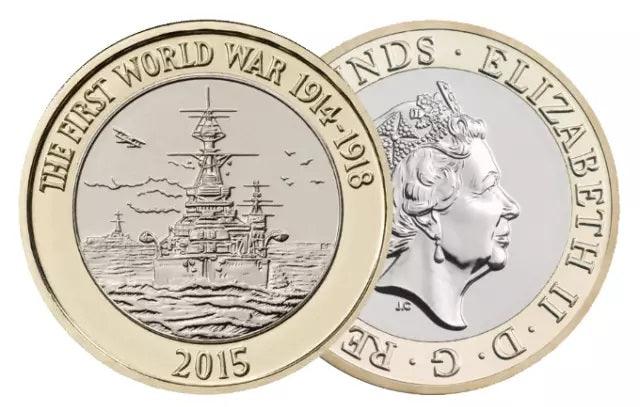The 2015 First World War Navy £2 coin is a remarkable piece that commemorates the Royal Navy’s crucial role during the First World War.
This coin is the second in a series of £2 coins introduced by the Royal Mint in 2014, each commemorating different aspects of the First World War.
The entire range includes 2014 FWW Outbreak coin, 2015 FWW Navy coin, 2016 FWW Army coin, 2017 FWW Aviators (not in circulation) and the 2018 Armistice Two Pound coin (not in circulation).
History of the coin
After the outbreak of war in 1914, the British Army realized its size was insufficient to sustain the conflict. The concept of “Pals Battalions” emerged, where friends, neighbours, and colleagues enlisted together, forming close-knit units.
This coin pays tribute to their courage and sacrifice during a pivotal moment in military history.
Design of the coin
The reverse design, created by artist David Rowlands, pays tribute to the Royal Navy’s contribution during the war.
The central image features a mighty battleship - a dreadnought type - symbolizing the naval power held by the Royal Navy.
The battleship depicted is based on the appearance of the HMS Belfast and the coin is often referred to as the HMS Belfast £2 coin.
Additional elements include clouds and a biplane in the background to the left (starboard side of the ship). It also has birds in flight to the right (port side of the ship).

The designer’s initials, DR, appear in the waves on the right side.
The text surrounding the design reads: “THE FIRST WORLD WAR 1914-1918” (top) and the centred date “2015” (bottom).
The edge inscription reminds us of the Royal Navy’s vital role: “THE SURE SHIELD OF BRITAIN.”
About the designer
David Rowlands, a respected military artist, has made significant contributions to coin design through his work with The Royal Mint. He was selected by the Royal Mint to design this coin, which marks one of the most important times in British history - the First World War.
He has a keen eye for historical significance and his work captures moments of courage, sacrifice, and the enduring legacy of the First World War.
The obverse of each coin shows the fifth portrait of Queen Elizabeth II, designed by Jody Clark. This is the first time the portrait has been used on £2 coins, having only been unveiled in 2015.

Surrounding her head all around the outer circle is her legendary ELIZABETH II D G REG F D 2 POUNDS which translates from Latin to mean Elizabeth the Second, by the Grace of God, Queen, Defender of the Faith.
Designed by Royal Mint engraver, Jody Clark, the fifth definitive UK coin portrait features a bust of Queen Elizabeth II wearing the King George IV State Royal Diamond Diadem Crown, which she wore for her Coronation in 1953. The initials JC, are just below the neckline of Her Majesty Queen Elizabeth II.
Jody Clark chose this to link his design to the past as it was featured in the designs by both Raphael Maklouf and Arnold Machin. The Queen is also wearing the Diamond Jubilee drop pearl earring 's and her chin is lifted slightly.
Mintage of the Coin
The 2015 First World War Navy £2 coin is exceptionally rare in circulation. Only 650,000 of these coins were released, making it the third rarest £2 coin in circulation and the fourth rarest coin across all denominations.
Apart from the circulated version, there were other versions issued for collectors. These versions were issued for collectors and are highly sought-after:
Brilliant Uncirculated: Mintage of 56,906.
Proof: Mintage of 15,921.
Silver Proof: Mintage of 3,694.
Silver Proof Piedfort: Mintage of 1,946.
Gold Proof: Mintage of 505.
How rare is the 2015 First World War Navy £2 Coin?
This coin is exceptionally rare in circulation. Only 650,000 of these coins were released, making it the third rarest £2 coin in circulation and the fourth rarest coin across all denominations.
The only £2 coins with lower mintages are the 2002 Commonwealth Games Northern Ireland and Wales coins.
Collectors highly value this rarity, contributing to its sought-after status.
How much is the 2015 First World War Navy Two Pound coin worth?
The 2015 First World War Navy £2 coin is worth around £8 in good condition, which is considerably more than face value and the value of this coin is steadily increasing.
Where can I buy the 2015 First World War Navy £2 Coin?
You can buy the 2015 First World War Navy £2 coin online on auction sites such as eBay or Amazon but please ensure you look at all the information and reputation of the seller.
Alternatively, you can buy it from us by clicking here.
Unfortunately, as this coin is now 9 years old, the Royal Mint no longer stocks this coin so it is only available to buy on the secondary market.
Are there any known errors of this coin?
There has been speculation about a second version of the coin featuring a flag flying from the top of the ship’s mast (half error). Or in some cases, two flags flying either side of the mast (full error).
However, this effect is actually the result of a cracked die, causing pools of metal to form on the coins during striking. It coincidentally resembles the shape of a flag.
These error coins, known as rotated die errors, are desirable among collectors and have sold for as much as £20.
The Royal Mint has not confirmed any errors for this particular coin.
Bit of trivia...
HMS Belfast is one of only three remaining vessels from the bombardment fleet which supported the Normandy landings on 6 June 1944. The other vessels are the destroyer USS Laffey, part of the historic ships grouped at Patriots Point, South Carolina, and the dreadnought battleship USS Texas at San Jacinto, Texas.
On 6 June 1944, HMS Belfast was the flagship of Bombardment Force E, supporting troops landing at Gold and Juno beaches. Her first target was the German gun battery at La Marefontaine. As a result of HMS Belfast’s bombardment, the battery played no meaningful role in the defence of the beaches.


1 comment
Scott Phelps
First World War £2 coin with casting error I can attach proof